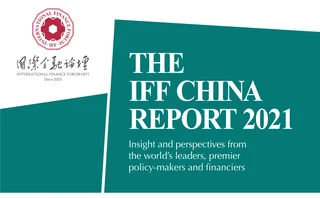
The irreversible rise of fintech in China


Fintech is one of the hottest topics in the world. Countries and regions have, to varying degrees, probed into this continually developing area.
Since China’s efforts to reform and its policy of opening-up began, technology has played an essential role in its financial sector – particularly in the past decade. It is fair to say that fintech, which has been actively applied to improve financial services and supervision, has played an irreversible role in the development of China’s financial sector.

With the advent of internet and mobile banking, finance in China, with fintech, has truly taken off and made a huge leap forward.
In the past few years, the Chinese government has laid the groundwork to allow for the networking of financial services and the migration to Europay, Mastercard and Visa chip cards. These foundations and the experience gained in the realm of innovative mobile finance have grounded China’s financial sector.
So far, the results of this digitalisation have been positive. China’s emphasis on fintech began a long time ago, but practitioners constantly absorb better ideas so our understanding is continually growing. China’s regulatory departments have always valued the application of science and technology in the financial sector, and see fintech as an important component in the construction of related infrastructures.
For regulatory bodies in charge of science and technology, the most arduous work was to allocate limited funding, in the form of appropriations from the state treasury to where it counts the most, while commercial banks face fewer rigidities in this regard. The People’s Bank of China’s systems responsible for payments, clearing and financial investigations require funds to build the infrastructures, including hardware, software, disaster recovery and global connectivity.
The People’s Bank of China recently announced the establishment of the Fintech Committee and the development plan for which it will be responsible. This plan identifies the guiding ideology, basic principles, objectives and key tasks for the committee in the coming years. One encouraging sign is that some key areas have introduced incentive policies in their own jurisdictions, including the Guangdong–Hong Kong–Macao Greater Bay Area.
Regulating fintech innovation
China’s regulatory framework is also constantly improving. In China, regulation is not seen as opposed to innovation but as complementary and mutually augmenting. China’s regulatory approach is both inclusive and explorative in the application of fintech. Last year, following the success of regulatory sandboxes created in countries including the UK and Singapore, the People’s Bank of China established tools to regulate fintech innovation. Regulatory sandboxes have been piloted in Beijing, Shanghai, Shenzhen, Xiong’an, Hangzhou and Guangzhou. In addition, a series of standards and rules are being created for areas including artificial intelligence, cloud computing, blockchain, mobile finance apps and data privacy protection. Financial and governance mechanisms that incorporate administrative supervision and industrial governance are gradually being formed.
As a result, China’s fintech industry has begun to flourish. Fintech can be applied in a number of ways, including traditional financial services firms reinvigorating products and services, as well as new entrants with new business formats and products.
The ecosystem of fintech is by and large abundant. The healthy interaction and competition among main actors have contributed to its continuous evolution. Other fintech-related facilities, such as industrial parks, incubators, featured towns and makerspaces, are also booming in China. In part, this is down to the successful fostering of talent through universities and research institutions. China already has certification systems for financial planners, investors and fintech talent, and it is stepping up efforts to roll out specific certification systems in many other fields.
In addition, China takes the education of fintech very seriously. More than 20 higher learning institutions across the country offer undergraduate degrees in fintech.
The application of Chinese fintech has also been a success. According to EY, the application rates of fintech among Chinese consumers and small and medium-sized enterprises are among the highest in the world: 87% and 61%, respectively. It is worth noting that economic activities such as payment, wealth management, lending and insurance were effectively immune to the Covid-19 outbreak thanks to the deployment of technology. Some commercial banking outlets were closed during the Covid‑19 pandemic for fear of contact infection; but online business continued to run. As a result, most of China’s financial services industry was uninterrupted by the virus – an outstanding achievement.
By the end of June 2020, the number of Chinese online payment users had exceeded 800 million. Interestingly, a large proportion of the elderly generation – not known for their technical skills – moved quickly to online forms of payment and mobile retail during the pandemic. During the lockdown, express delivery and logistics companies also made changes, reinforcing a change in consumer habits. With the support of convenient and efficient online payment tools, as of December 2020, the utilisation rates of online wealth management, food delivery and shopping reached 17.2%, 42.3%, and 79.1%, respectively. Uptake of online wealth management is relatively low because a large proportion of the elderly population continues to have qualms about using the internet. But it has become an indispensable infrastructure for financial activities: 85.7% of all Chinese citizens now use online payments.
Room for improvement
Accelerated by the pandemic, China’s fintech sector has developed successfully – though some work remains. The following principles need to be understood and implemented correctly.
First, value orientations must be correct. When carrying out fintech activities, we must always consider the bottom line as the first responsibility. The financial sector is laden with high risk, biased emphasis and inherent frangibility. Fintech solves problems and improves efficiency, but financial risks have also increased. So, while fintech has improved the capability to prevent and resolve risk, it cannot completely eradicate it. There is also a need to regulate technology – in the right hands it can lead to better inclusion and efficiency but, in the wrong hands, it could be used to facilitate illegal activities.
Second, fintech activities must adhere to financial services legislation. Only by properly implementing these laws can we ensure fintech activities do not harm consumers. China needs to implement new legislation, based on its experience with the fintech industry, which applies the appropriate level of regulation to the sector. Financial practitioners should fully recognise that compliance supervision is not a barrier for fintech innovation but a guiding light or guardrail on the path forward. Fintech can only maintain long-term stability and prosperity if it innovates under the premise of political integrity and unswervingly adheres to the people-oriented principle.
Third, the sector should take advantage of innovation-driven development. President Xi Jinping has emphasised on numerous occasions that China’s mission should be to build an innovation system that closely integrates technology, education, industry and finance. Digital technology is the most concentrated field of innovation, with the greatest dynamism to facilitate growth in other fields. The past 40 years’ history of China’s reform and opening-up has shown that innovation and reform are the most fundamental driving forces for development. In the digital age, we must learn how to master digital technology so finance can better serve the real economy. If China’s financial institutions, whether conventional or emerging, turn a deaf ear or a blind eye to digital technology, they will eventually be eliminated. Those that use digital technology earlier in a safer and more reasonable manner, and pay attention to solving fragilities and pain points in the current financial system, will be able to take the initiative and win more dividends. China needs to focus on creating an inclusive and prudent fintech mechanism for innovation, fault tolerance, trial and error, and error correction at both policy and institutional levels. By such efforts, China can shift the focus of digital technology within the business cycle from acquiring customers through marketing, to more important tasks such as risk management, procedure management and ecological operation.
Fourth, secure infrastructure must be maintained. How far fintech will go ultimately depends on infrastructure construction. The World Bank published a report in October 2020 on financial management departments in 114 countries and regions, which indicated that, after the Covid-19 outbreak, 72% of the interviewed institutions had stepped up or were preparing to launch digital infrastructure. It is widely recognised there is an urgent need for global financial institutions to reinforce and support existing digital infrastructure. From the perspective of the financial sector, the best, most advanced and most practical technology must be used to renovate areas including payments, credit enquiry, lending, securities and insurance. Technologies such as blockchain, multiparty computing and federated learning can be applied to the financial sector. However, as the world becomes increasingly digital, the issue of data privacy becomes more challenging and requires further research.
Finally, China must establish a diversified governance mechanism to make good use of fintech and develop it with a view to upgrading its financial sector. The traditional governance mechanism is divided by institution or by process. As the sector continues to evolve through the application of technology, a series of transformations will occur. China’s supervisory bodies must keep pace with the times, and establish a multi-level fintech governance system including legal constraints, administrative supervision, industrial self-discipline, institutional self-control and social supervision. Progress in this arena has already begun through the implementation of a new sandbox, and innovation linked to reporting, auditing standards, risk monitoring and consumer protection. In this way we have incorporated industrial self-discipline and social supervision into the traditional governance pattern, supported by government and institutional supervision.
Only users who have a paid subscription or are part of a corporate subscription are able to print or copy content.
To access these options, along with all other subscription benefits, please contact info@centralbanking.com or view our subscription options here: subscriptions.centralbanking.com/subscribe
You are currently unable to print this content. Please contact info@centralbanking.com to find out more.
You are currently unable to copy this content. Please contact info@centralbanking.com to find out more.
Copyright Infopro Digital Limited. All rights reserved.
As outlined in our terms and conditions, https://www.infopro-digital.com/terms-and-conditions/subscriptions/ (point 2.4), printing is limited to a single copy.
If you would like to purchase additional rights please email info@centralbanking.com test test test
Copyright Infopro Digital Limited. All rights reserved.
You may share this content using our article tools. As outlined in our terms and conditions, https://www.infopro-digital.com/terms-and-conditions/subscriptions/ (clause 2.4), an Authorised User may only make one copy of the materials for their own personal use. You must also comply with the restrictions in clause 2.5.
If you would like to purchase additional rights please email info@centralbanking.com test test test







